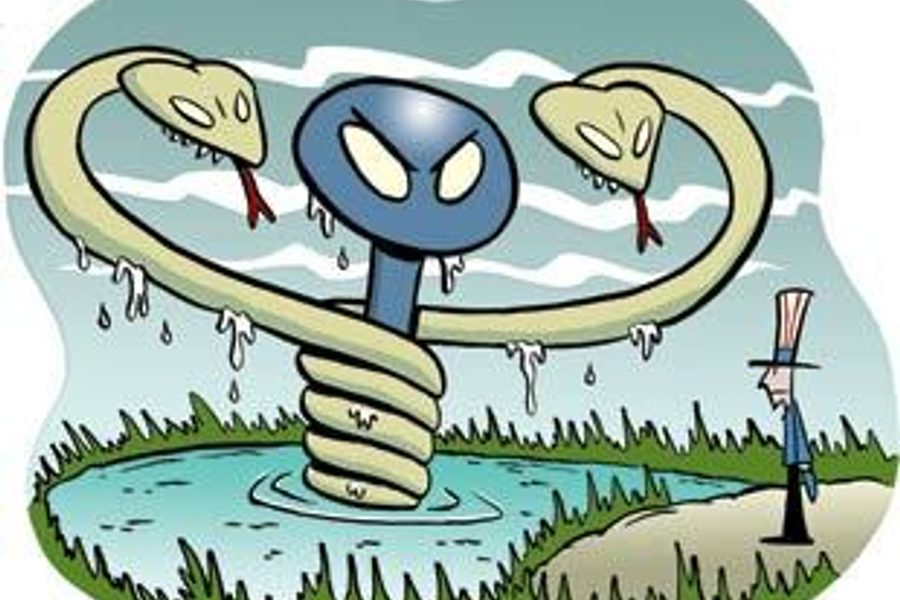
Are serial killers beyond redemption? Two new films consider the case of Aileen Wuornos, a woman executed by Florida in 2002 for killing seven men with a .22-caliber pistol. Although the films differ in their portrayal of Wuornos, both attempt to see beyond the media’s sensationalism and make an emotional argument against the death penalty.
In Monster, writer-director Patty Jenkins frames Wuornos within a love story. After an opening monologue in which she describes her wish to find Prince Charming, Aileen (Charlize Theron) meets Selby Wall (Christina Ricci) in a seedy gay bar. They make an unlikely couple: Selby is a young, clean-cut Midwestern Catholic who has been sent to live with her aunt after her father discovered her homosexuality; Aileen is a rough homeless woman who has been prostituting for the past 10 years on the interstate. Selby’s vulnerability and Aileen’s desperation make a quick, potent match, and they set off together to live as a couple in rural Florida.
Jenkins follows Aileen’s psychological descent closely: her desire to support and provide for Selby, her perilous escape from a sadistic client, her attempt and failure at legal employment and her humiliating return to prostitution all culminate in the ruthless murders she inflicts.
Though Aileen appears beset by destructive impulses, Selby’s adoration forces us to consider her as someone worthy and capable of love. The presence or lack of love informs much of Aileen’s identity; throughout we glimpse her tragic childhood of abuse and abandonment, and her tumultuous adolescence of living on the streets. With Selby, her anger and bitterness breaks, and she is tender and hopeful. In the blissful early scenes of awkward courtship, especially when Aileen and Selby kiss in the skating rink with a Journey song swelling in the background, it is difficult to imagine Aileen as someone who could commit atrocities worthy of execution.
So the ultimate horror of her murders poses these questions: Could her love for Selby have prevented them? Or, did it push her over the edge?
Made on a modest budget by a first time writer-director, Monster is outstanding by any standard. Despite compressing timelines and condensing key players, it stays true to its source material, is fair to its subjects and provides an open spectrum within which to consider Aileen and her actions.
Theron gives a ferocious, detailed performance that articulates Aileen’s complexities. More than the sum of her swagger, drawl and thousand nervous gestures, she embodies her character so seamlessly that the film’s artifice seems to disappear. Ricci also does a fine job in creating Aileen’s vulnerable, ingenuous counterpart that sets their co-dependent dynamic in motion.
————–
Nick Broomfield’s documentary picks up where Monster ends. Aileen: Life and Death of a Serial Killer is even more sympathetic than Monster, as Broomfield frames Wuornos as a woman who has lost her mind.
Broomfield’s 1992 documentary, Aileen Wuornos: The Selling of a Serial Killer, depicted how her lawyer, adopted mother, ex-girlfriend and arresting officers conspired to profit off Wuornos’ story through secret book and movie deals. When Broomfield meets Wuornos a decade later, none of the charges have been prosecuted and she is delirious with rage. She tells him that she wants to come clean with her crimes and die as soon as possible.
Recounting her difficult childhood in Troy, Michigan, Wuornos says she cannot remember a single happy moment. She muses that if things had been different she might have turned out better. Her friends, relatives and ex-lovers agree with her: They recount sad stories from her past and then return to Michigan to visit her childhood home, the woods she lived in and places she caroused.
However, Wuornos becomes increasingly paranoid, and in her final interview describes how the police knew about the first murder and allowed her to continue killing so they could make money off her story. When Broomfield questions the validity of her conspiracy theories, she ends the interview yelling, “You’re an inhumane bunch of bastards and bitches.” All this, and yet she passed two psychological examinations the day before.
Broomfield sometimes undermines his sober tone by indulging in garish, unflattering close-ups of Wuornos during her tirades—with her crooked teeth and wide circling eyes, she looks like a drowning rat gasping for air.
Still, Broomfield’s closeness with Wuornos is felt throughout the film. His tabloid journalist demeanor is muted by the tragedy of his mission—to reconstruct the life of a woman against the backdrop of her impending death. He lets Wuornos speak and come clean, though she does not come to terms with her crimes before her time runs out. Instead of redemption, the long wait on death row has sown madness in its place.
In Monster, writer-director Patty Jenkins frames Wuornos within a love story. After an opening monologue in which she describes her wish to find Prince Charming, Aileen (Charlize Theron) meets Selby Wall (Christina Ricci) in a seedy gay bar. They make an unlikely couple: Selby is a young, clean-cut Midwestern Catholic who has been sent to live with her aunt after her father discovered her homosexuality; Aileen is a rough homeless woman who has been prostituting for the past 10 years on the interstate. Selby’s vulnerability and Aileen’s desperation make a quick, potent match, and they set off together to live as a couple in rural Florida.
Jenkins follows Aileen’s psychological descent closely: her desire to support and provide for Selby, her perilous escape from a sadistic client, her attempt and failure at legal employment and her humiliating return to prostitution all culminate in the ruthless murders she inflicts.
Though Aileen appears beset by destructive impulses, Selby’s adoration forces us to consider her as someone worthy and capable of love. The presence or lack of love informs much of Aileen’s identity; throughout we glimpse her tragic childhood of abuse and abandonment, and her tumultuous adolescence of living on the streets. With Selby, her anger and bitterness breaks, and she is tender and hopeful. In the blissful early scenes of awkward courtship, especially when Aileen and Selby kiss in the skating rink with a Journey song swelling in the background, it is difficult to imagine Aileen as someone who could commit atrocities worthy of execution.
So the ultimate horror of her murders poses these questions: Could her love for Selby have prevented them? Or, did it push her over the edge?
Made on a modest budget by a first time writer-director, Monster is outstanding by any standard. Despite compressing timelines and condensing key players, it stays true to its source material, is fair to its subjects and provides an open spectrum within which to consider Aileen and her actions.
Theron gives a ferocious, detailed performance that articulates Aileen’s complexities. More than the sum of her swagger, drawl and thousand nervous gestures, she embodies her character so seamlessly that the film’s artifice seems to disappear. Ricci also does a fine job in creating Aileen’s vulnerable, ingenuous counterpart that sets their co-dependent dynamic in motion.
————–
Nick Broomfield’s documentary picks up where Monster ends. Aileen: Life and Death of a Serial Killer is even more sympathetic than Monster, as Broomfield frames Wuornos as a woman who has lost her mind.
Broomfield’s 1992 documentary, Aileen Wuornos: The Selling of a Serial Killer, depicted how her lawyer, adopted mother, ex-girlfriend and arresting officers conspired to profit off Wuornos’ story through secret book and movie deals. When Broomfield meets Wuornos a decade later, none of the charges have been prosecuted and she is delirious with rage. She tells him that she wants to come clean with her crimes and die as soon as possible.
Recounting her difficult childhood in Troy, Michigan, Wuornos says she cannot remember a single happy moment. She muses that if things had been different she might have turned out better. Her friends, relatives and ex-lovers agree with her: They recount sad stories from her past and then return to Michigan to visit her childhood home, the woods she lived in and places she caroused.
However, Wuornos becomes increasingly paranoid, and in her final interview describes how the police knew about the first murder and allowed her to continue killing so they could make money off her story. When Broomfield questions the validity of her conspiracy theories, she ends the interview yelling, “You’re an inhumane bunch of bastards and bitches.” All this, and yet she passed two psychological examinations the day before.
Broomfield sometimes undermines his sober tone by indulging in garish, unflattering close-ups of Wuornos during her tirades—with her crooked teeth and wide circling eyes, she looks like a drowning rat gasping for air.
Still, Broomfield’s closeness with Wuornos is felt throughout the film. His tabloid journalist demeanor is muted by the tragedy of his mission—to reconstruct the life of a woman against the backdrop of her impending death. He lets Wuornos speak and come clean, though she does not come to terms with her crimes before her time runs out. Instead of redemption, the long wait on death row has sown madness in its place.
Todd Lillethun is a writer and filmmaker in Chicago.








